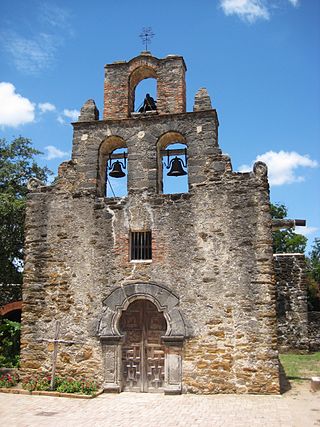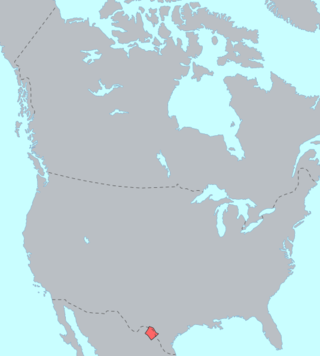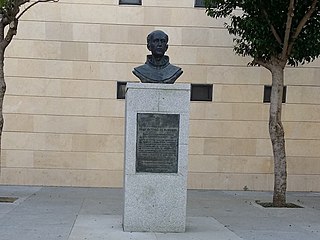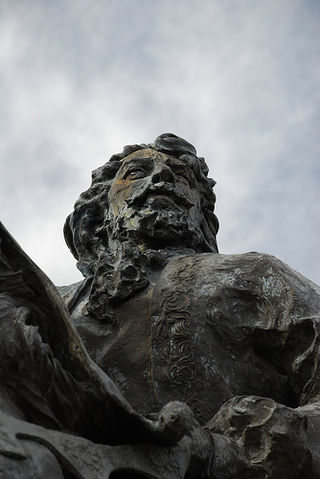Related Research Articles

Los Adaes was the capital of Tejas (Texas) on the northeastern frontier of New Spain from 1721 to 1773. It included a Franciscan mission, San Miguel de Cuéllar de los Adaes, and a presidio, Nuestra Señora del Pilar de Los Adaes. The name Adaes derives from the indigenous Adai people, members of the Caddoan confederacy of Indians who were the people the missionaries aimed to convert to Christianity. The presidio and mission were established to counter French influence in Louisiana territory and defend New Spain from possible invasion or encroachment by the French. In 1763 Louisiana came under the control of Spain and the Los Adaes outpost was no longer necessary for defense. In 1773 the Spanish closed the mission and presidio and forced the population to move to San Antonio.

The Spanish Missions in Texas comprise the many Catholic outposts established in New Spain by Dominican, Jesuit, and Franciscan orders to spread their doctrine among Native Americans and to give Spain a toehold in the frontier land. The missions introduced European livestock, fruits, vegetables, and industry into the Texas area. In addition to the presidio and pueblo (town), the misión was one of the three major agencies employed by the Spanish crown to extend its borders and consolidate its colonial territories.

Mission San Francisco de la Espada is a Roman Rite Catholic mission established in 1690 by Spain and relocated in 1731 to present-day San Antonio, Texas, in what was then known as northern New Spain. The mission was built in order to convert local Native Americans to Christianity and solidify Spanish territorial claims in the New World against encroachment from France. Today, the structure is one of four missions that comprise San Antonio Missions National Historical Park.

The Spanish missions in Mexico are a series of religious outposts established by Spanish Catholic Franciscans, Jesuits, Augustinians, and Dominicans to spread the Christian doctrine among the local natives. Since 1493, the Kingdom of Spain had maintained a number of missions throughout Nueva España in order to preach the gospel to these lands. In 1533, at the request of Hernán Cortés, Carlos V sent the first Franciscan friars with orders to establish a series of installations throughout the country.

Solano is an unclassified extinct language formerly spoken in northeast Mexico and perhaps also in the neighboring U.S. state of Texas. It is a possible language isolate.
Von Ormy is a city in southwest Bexar County, Texas, United States. As of the 2020 census, it had a population of 1,174. It is part of the San Antonio metropolitan statistical area.

Antonio Margil, OFM was a Spanish Franciscan missionary in North and Central America. Based at the College of Santa Cruz in Santiago de Querétaro, after 1715, he worked largely in Texas and Louisiana. Father Margil was declared "Venerable" in 1836.
Martín de Alarcón was the Governor of Coahuila and Texas from 1705 until 1708, and again from 1716 until 1719. He founded San Antonio, the first Spanish civilian settlement in Texas.

The City of San Antonio is one of the oldest Spanish settlements in Texas and was, for decades, its largest city. Before Spanish colonization, the site was occupied for thousands of years by varying cultures of indigenous peoples. The historic Payaya Indians were likely those who encountered the first Europeans.

Antonio de San Buenaventura y Olivares or simply Fray Antonio de Olivares was a Spanish Franciscan who officiated at the first Catholic Mass celebrated in Texas, and he was known for contributing to the founding of San Antonio and to the prior exploration of the area. He founded, among other missions, the Alamo Mission in San Antonio, the Presidio San Antonio de Bexar, and the Acequia Madre de Valero.
Isidro Félix de Espinosa (1679–1755) was a Franciscan missionary from New Spain who participated in several expeditionary missions throughout the province of Tejas. He was the president of the missionaries from the College of Santa Cruz de Querétaro.

Francisco Cuervo y Valdés was a Spanish politician who governed Nuevo León (1687-1688), Nueva Extremadura (1698–1703), New Philippines (1698–1702), and Santa Fe de Nuevo México (1704–1707).

Presidio de Béxar was a Spanish fort built near the San Antonio River, located in what is now San Antonio, Texas, in the United States. It was designed for protection of the mission San Antonio de Valero and the Villa de Béjar. The Presidio de Béxar was founded on May 5, 1718 by Spanish colonial official Martín de Alarcón and his party of thirty-five soldiers. The Villa de Béjar is known for being the first Spanish settlement of San Antonio and consisted of the families of the Presidio Soldiers and those of the prior expeditions. It also served to secure Spain's claim to the region against possible encroachment from other European powers.
The Xarames were an Indigenous people of the Americas of the San Antonio, Texas region. They were the dominant Native American group during the early history of Mission San Antonio de Valero. They were a Coahuiltecan people.

The Coahuiltecan were various small, autonomous bands of Native Americans who inhabited the Rio Grande valley in what is now northeastern Mexico and southern Texas. The various Coahuiltecan groups were hunter gatherers. First encountered by the Spanish in the 16th century, their population declined due to Old World diseases and numerous small-scale wars fought against the Spanish, Apache, and other Indigenous groups.

The Payaya people were Indigenous people whose territory encompassed the area of present-day San Antonio, Texas. The Payaya were a Coahuiltecan band and are the earliest recorded inhabitants of San Pedro Springs Park, the geographical area that became San Antonio.

The Mexican Secularization Act of 1833, officially called the Decree for the Secularization of the Missions of California, was an act passed by the Congress of the Union of the First Mexican Republic which secularized the Californian missions. The act nationalized the missions, transferring their ownership from the Franciscan Order of the Catholic Church to the Mexican authorities.
The Pastia people were a hunter-gatherer tribe of the Coahuiltecan. The Pastias inhabited the area south of San Antonio, largely between the Medina and San Antonio Rivers and the southward bend of the Nueces River running through modern day La Salle and McMullen counties. They were first contacted by Spanish explorers in the early eighteenth century, and were extinct as an ethnic group by the middle of the following century.
José Domingo Ramón was a Spanish military man and explorer who founded several missions and a presidio in East Texas to prevent French expansion in the area.
The Sijame were an Indigenous people of the Americas of the San Antonio, Texas region. Some historians believe they were a band of Tonkawa, but they were likely a Coahuiltecan people.
References
- 1 2 3 Barr, Juliana (19 March 2007). Peace Came in the Form of a Woman: Indians and Spaniards in the Texas Borderlands (1st ed.). The University of North Carolina Press. pp. 112, 123, 146. ISBN 978-0-8078-5790-8.
- 1 2 "San Juan Bautista". Texas State Historical Association. Retrieved 9 February 2024.
- 1 2 3 4 Weddle, Robert S. "San Francisco Solano Mission". Handbook of Texas Online. Texas State Historical Association. Retrieved September 28, 2012.
- ↑ Campbell, Thomas N. "Payaya Indians". Handbook of Texas Online. Texas State Historical Association. Retrieved September 18, 2012.